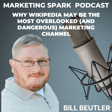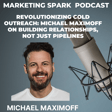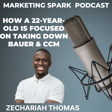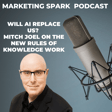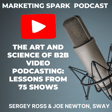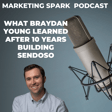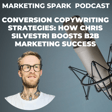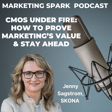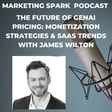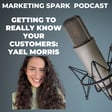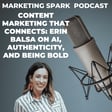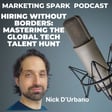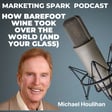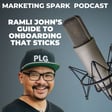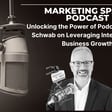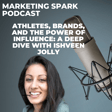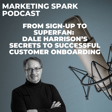Become a Creator today!Start creating today - Share your story with the world!
Start for free
00:00:00
00:00:01

Don't Let Content Collect Dust. Distribute & Repurpose: Ross Simmonds
Many marketers believe that when they hit "publish" on a piece of content, the job is done.
But the reality is it's just beginning.
Ross Simmonds says one of the keys to content marketing success is distribution. Without it, he says all you're doing is building a content library.
In this episode of Marketing Spark, Ross talks about:
- Why so many companies and marketers struggle with content distribution
- How to kick-start a content distribution plan
- How to repurpose content on multiple platforms
- Why it's important to focus on quality, not quantity
- How to create content that's valuable and SEO-friendly.
Transcript
The Challenge of Content Distribution
00:00:05
Speaker
Hi, it's Mark Evans, and you're listening to Marketing Spark. When I wrote my first marketing book, someone told me that writing the book was the easy part. Marketing and distribution were the biggest challenges. It was a lesson that I painfully discovered. In many respects, the same rules apply to content marketing. Creating content is easy, relatively speaking. Distribution is hard.
Introducing Ross Simmons: A Content Distribution Advocate
00:00:29
Speaker
If no one consumes your content, it's a lot of hard work down the drain.
00:00:34
Speaker
Now, if you're looking for an advocate or evangelist for content distribution, it's Ross Simmons, CEO at Foundation Marketing, a content marketing agency in Halifax. On LinkedIn, YouTube, blogs, and podcasts, you'll hear Ross pounding the table about content distribution.
Ross Simmons: Top Content Marketer and Canadian Pride
00:00:52
Speaker
Welcome to Marketing Spark, Ross. Thanks for having me, Mark. It's a pleasure to connect. I've been a big fan of the work that you've done for the community over the years, so it's a complete pleasure, and I'm looking forward to chatting about my favorite topic today.
00:01:04
Speaker
Well, it's nice talking to a fellow Canadian marketer. I read today on LinkedIn that you have been named a top 100 content marketer by BuzzSumo. That is a great recognition. Thank you. Yeah, it feels great. I was number three out of a list of 100, which feels good. I'm trying to represent for the Canadian marketers around the world. We got to number three. My next step is to try to get to the number one spot. So lots more work still to be done, but I'm super thrilled and happy to be on that list.
00:01:34
Speaker
Well, I'm sure if there was voting, a score of Canadian marketers would rally behind you. So that's the greatest accomplishment. I appreciate it.
Companies' Struggle with Content Distribution
00:01:43
Speaker
All right. Let's start with the obvious question, the $64,000 question. Why do so many companies struggle with content distribution? You would think that it would be an integral part of an overall content marketing strategy. Yeah.
00:01:56
Speaker
I think the biggest reason is a lot of organizations are fundamentally built internally and have a content culture that is built internally around the wrong thing. And what I mean by that is a lot of the organizations and a lot of the companies, the marketing engines, the content engines within these companies
00:02:12
Speaker
They're built around a production mindset and that production mindset is where they believe value is being created and delivered on behalf of marketing every time they press publish. So they're viewing it as a production game when in reality it's a
00:02:29
Speaker
fundamental marketing game, which is you have to market the things that you produce. So rather than us falling into the trap, as marketers and a lot of companies do this, of thinking our job is done when we press publish on a blog post, on an ebook, on a white paper, on a webinar, on a podcast, on a tweet, on a LinkedIn update, et cetera, instead of thinking that that is when the job is done,
00:02:49
Speaker
We need to be thinking that is when the job begins. But for many organizations, they are tracking and monitoring how many pieces of content did this marketer create? How many pieces did this agency create for us? And they're actually benefiting or aligning their incentives
00:03:06
Speaker
around output rather than the results of the output, which is more correlated with distribution. That, I would say, is one of the fundamental issues.
Distribution Beyond Social Media
00:03:15
Speaker
Then the second one would be that a lot of people just don't understand the importance of distribution at large across all different types of metrics. Distribution is important if you're talking about sales enablement. Distribution is important if you're talking about social media. Distribution is important if you're talking about company culture.
00:03:33
Speaker
Distribution is a key part of every element of marketing. But for some reason, it's often looked at as just a top of funnel, high level social media, funny thing. But in reality, it can touch every element of the marketing engine.
00:03:47
Speaker
In a way, it reminds me of those late night infomercials you used to see featuring this guy named Ron Popiel. And he had this tagline that was, set it and forget it. And it sounds like a lot of marketers are taking that approach to content. It's write it and forget it. And that strikes me as really interesting because you know as a content marketer how much work goes into writing a good piece of content, the research, the interviews.
00:04:12
Speaker
the writing, the editing, the polishing. And you finally get it into a place where you've invested so much time and effort. You hit publish, which is very satisfying. And it's almost like the whole thing is half baked. They forget that there's a whole other side of the equation. And maybe it has come down to the mentality that you talk about, but maybe it's that we're just not, we're not thinking about it. We're not trained properly when it comes to distribution.
00:04:36
Speaker
Yeah. And it does, you do get a nice little dopamine rush when you press publish on a piece of content, right? Like you feel good to press publish and that you want that again. So you continue to do it. You continue to press publish. You continue to do that constantly, um, without recognizing that if you get in the habit of just pressing publish, eventually you're just going to have a collection of content, a collection of assets, but those pieces aren't serving you when you're not amplifying them, promoting them and distributing them appropriately.
Understanding Audience and Channel Habits
00:05:03
Speaker
So if you were to develop a content marketing distribution plan, where do you start? Because I think a lot of marketers in theory like the idea of publishing content and then distributing it in multiple places so you can expand the size of the audience. But when it comes down to practical realities, they're busy. They've got other priorities. They're moving on to the next project or the next piece of content. So they don't think about distribution. So help them
00:05:29
Speaker
frame the whole distribution plan so they can actually drive more ROI from the content that they're producing? Yeah, I love this question because it starts with the fundamentals of marketing. And I think there's a lot of content firms. I think there's a lot of companies, a lot of leaders in the content space that over focus on content without actually worrying about the marketing side. And the marketing side is where we have to root all of our efforts. So let's go back to fundamentals of marketing.
00:05:55
Speaker
And where does that start? It starts with the people you're trying to serve and the people you're trying to connect with. So what I would say you start with is trying to understand and understand and connect with the people you're trying to reach. You're looking to get alignment in the actual product that you have and the customers. So you can go back to fundamentals, who do we serve, who do we want to use our product, use our service, et cetera. And then you have to start analyzing and studying them as people and them as professionals and their needs, their motivations.
00:06:24
Speaker
But I would advise is that you start to look at things like channel user fit. And what channel user fit is, is it's the idea that different people are going to spend time on different channels. So what you're going to start to do is you're going to navigate and study what channels are these users spending time on. And when you identify that, okay, this audience, this target that we're going after, let's say it's CTOs, the CTOs that we're trying to reach are spending time on LinkedIn.
00:06:49
Speaker
They're spending time on Reddit. They're spending time on GitLab, GitHub, they're spending time in AngelList. They're spending time on Hacker News, all of these different sites. You now have channel user fit.
00:06:59
Speaker
Now, once you have that, you have to start looking for content user fit. So how do you do that? You start to look at these channels and start to study what are the best pieces of content that have been published in these channels that these communities and this audience of CTOs actually wanted. And when you start to see trends between, okay, when we look at this subreddit and we see a bunch of CTOs always talking about this certain subject,
00:07:22
Speaker
That is an insight. It's an insight into the fact that we can come into this community with stories about this topic and they're going to resonate with it. And if you can do that consistently, you're going to have what we call content market fit. So the research process for a distribution engine starts by understanding your audience better than your competitors. And when you understand your audience better than your competitors, you then need to look at what channels they're spending the vast majority of their time on.
00:07:48
Speaker
Once you have that, you're going to study the best content on that channels to inform the content you create in the future. But that's not what you're going to kind of call the end of that process. You also need to be looking at whether or not your competitors are using those channels. Because if you find out that your competitors are ignoring a channel that is highly popular with your target audience because they view it as being a risky channel, then that is something that I believe is a goldmine for any brand to take advantage of.
00:08:18
Speaker
If you see that your audience is spending a bunch of time in a subreddit with hundreds of thousands of people, but everybody in your industry is like, whoa, we're scared of Reddit. That is your opportunity to be the early adopter into that channel, to capture mindshare, to distribute your stories in there, to distribute your content consistently and capture value that your competitors have overlooked.
00:08:39
Speaker
So the way that you can ensure that when you do go into this channel, something that you're formed with is that approach of studying the content that people want on that channel. And then when you get that, when you study that and you know it, it makes it easier for you to distribute your content in a format that those people are going to want. And it's going to ultimately set you up for success as you distribute your content across multiple channels in the months to come.
00:09:03
Speaker
I really liked that approach because it aligns with my walk before you run philosophy when it comes to marketing. And a lot of marketers are focused on tools and technology and tactics. And often we don't take a step back and think about the strategic approach that we should take to anything marketing related, including content. And I think what you're saying, and I see this a lot on LinkedIn is the
00:09:28
Speaker
the fact that you need to know your customers inside out, you need to know their habits, how they buy, what kind of content they consume. And if you get that in place, then, as you say, it's a lot easier to figure out, okay, I got to distribute my content here, here and here. And this is the kind of content that matters to them. Right. And you've done this well, like, you know, that CMOs, like, you know, that CEOs, like that space is spending time on LinkedIn. So by
00:09:53
Speaker
investing the time upfront in understanding that audience and becoming one with your audience in many ways, you've been able to successfully develop and deliver content just like this podcast on a consistent basis that your audience loves. It's all about knowing your audience, loving your audience, and I know that sounds weird, but you really do have to love them to that point where you know everything about them. The other angle of content distribution that you talk a lot about, and it's so important, is the idea of content repurposing.
00:10:21
Speaker
and the idea that you create it once and you turn it into multiple things and maybe you can provide some insight on how does that happen? Walk me through an example of how to turn a single piece of content into a multifaceted asset.
Maximizing Content Value through Repurposing
00:10:36
Speaker
This is a great insight for anyone who has ever pressed publish on a piece of content and they were like, this is really good, but we don't know how to get the maximum amount of value out of it. So when you press publish on, let's say, a blog post, because that's typically a pretty standard piece of content that a lot of organizations create, let's say you've created an in-depth blog post that is very valuable to your audience and your community.
00:10:57
Speaker
That blog post doesn't live and die on your blog. You're going to repurpose it. How do you do that? You're going to turn it into a Twitter thread. So you're going to take that introduction that you've already created that is captivating and you're going to reformat that to make it in very interesting and unique first tweet that you're going to send out and then you're going to have multiple tweets underneath it that are going to break up some of the key points below it. Then at the bottom of that Twitter thread, you're going to have a link driving back to the original post and people can get the full in-depth article over there.
00:11:23
Speaker
In addition to that, you're going to take that entire blog post and you're going to turn it into a slide deck. You're going to turn it into a presentation, you're going to bring in a designer to turn it into something beautiful, and you're going to upload a PDF directly into LinkedIn under their file section. You're going to take that, you're going to do screenshots of every slide and update it to Instagram so you have a carousel that you can republish and share on your Instagram account.
00:11:46
Speaker
And this is, again, all off of one blog post. You're then going to take some of those screenshots and those visuals, and you're going to upload those individually as assets to Twitter. And you're going to say, here's a concept, here's an idea. This is a tidbit. And you're going to share those one-offs on your various Twitter account. You're also going to take that same Twitter thread that you had, and you're going to add a little bit more meat to it, which is going to get it in between the blog post and the Twitter thread. And you're going to republish that as a long form asset
00:12:16
Speaker
on something like Reddit. You're going to take elements of that Reddit post and you're going to share those little tidbits on LinkedIn as just status updates. So you're taking paragraphs after paragraphs, finding the key nugget, finding the key insight, and you're sharing them as one-off updates on LinkedIn, on Twitter as different Twitter threads.
00:12:34
Speaker
Facebook. And while you're doing all of this, you're keeping an eye on Facebook groups to see if anybody's asking a question so you can go in and start to share some of those visuals that you had in your slide share presentation directly in the comments in a group that's targeting your target audience. So when we talk about creating once and then repurposing and distributing forever,
00:12:54
Speaker
The opportunity is truly endless. Like today, in this moment, I can go on Twitter and I can do a Twitter search for somebody who's talking about SEO, talking about Reddit, talking about Excel, talking about the unbundling of SaaS, all of these different things. And if I find someone tweeting about those things, I can get into that conversation, share a screenshot of a graphic, of a visual, of a blog post that I have shared in the past.
00:13:18
Speaker
send it to them, and that is content repurposing. And those people are going to engage with it. They're going to interact with it. But a lot of people, as we talked about earlier, will create a bunch of content, let that content collect dust, and then wonder why they're not able to generate traction and traffic on the back of it for years, if not decades to come. But the key is to repurpose it, remix it, and revise old content and keep it alive. So another reaction of a lot of people
00:13:43
Speaker
will be Ross. That sounds amazing. And if you can do that, I mean, your content distribution will explode, but the reality is, is that you're talking about people who may not have enough time, may not have the tools, may not have the aptitude or the energy. So how do you drive those kinds of efficiencies? How do you do all the things that you've prescribed?
00:14:07
Speaker
in a way that fits into the amount of time they've got and their other marketing priorities?
Focusing on Distribution over New Content
00:14:12
Speaker
There's a few ways that you can go about it. I think the key is to realize this is a job. It's a job. It's not just something that you say, I'm going to get an intern to come in and do content distribution. Now, this is a job. It's ideally someone who has studied distribution, who has spent time doing distribution, has understood it, can think in a mindset that is distribution,
00:14:36
Speaker
and then they can execute on it. So you can take the approach where you hire someone, that is 100% an opportunity. The other thing that you could do if you are strapped for resources and you can't bring in someone full time, is you have to do a bit of a gut check and ask yourself, do we really need to create more content? Like how much content have we already created this year? I fundamentally believe that every year by about Q2 in the year, most companies have created enough content and they can calm down, they can press pause, they can slow down and they don't need to actually create anything else.
00:15:06
Speaker
they can just start distributing the content assets that they've already created. So for some organizations, they need to just do a gut check internally to say, do we really need another white paper? Do we really need another blog post? And start taking that time and allocating it to distribution. And then the next option is that you bring in experts. You bring in third parties, you bring in organizations like Foundation, of course, Shameless Plug, but you bring in organizations who specialize in content distribution to actually run your distribution engine on your behalf.
00:15:36
Speaker
In a recent LinkedIn post, I suggested that the next hot marketing job would be the director or VP of content distribution. Thoughts?
The Need for a VP of Content Distribution
00:15:45
Speaker
I love it. And the reason why is this, we've been preaching for so long at the top of our lungs, every marketer, every guru, every CMO, content is king, content is king. And guess what? Congratulations, folks. Everybody has listened. Now we all get it. We all get this idea that content is important. We've got the VP of content. We've got the director of content. All of these roles now exist. But here's the issue.
00:16:07
Speaker
We're investing so heavily in this content that is collecting dust, as we're talking about. So we need someone to partner with the person who's leading content to ensure that that content has legs. So the VP of content distribution, I believe, is going to be an crucial role, especially when you look at the narrative and the conversation happening right now around every organization needing to be a media company.
00:16:31
Speaker
Okay, it's great to be a media company. That whole mentality and that thought process is strong. But does everyone remember what the media companies used to have? Like let's go back to the traditional newsletters, like the newspaper companies. What did they have? They had distribution directly to your doorstep. People had subscriptions that they were willing to pay for where newspapers would get dropped off at your door and there would be hundreds of kids running around the city throwing newspapers at your door. There is no better distribution than that.
00:17:01
Speaker
They no longer have that because of the internet and their businesses have crumbled. So we can act like media companies where we will create great newsletters and great newspapers, great blog posts, great white papers. But if we don't have a bunch of newspaper runners and carriers to take the assets that we are creating and investing in and getting them in front of our people, in front of our audiences, we're going to be just like the newspaper industry.
00:17:24
Speaker
So yes, I 100% buy into the idea that a VP of content distribution should be a role that everyone is thinking about. And if you are not there yet, if today you're listening to this and you're like, I'm not there yet, start internally with a medium senior role, right? Because that person will grow in your org and they will eventually get there. But give someone the responsibility of content distribution and it will pay massive dividends, I believe, long-term.
00:17:51
Speaker
as someone who delivered newspapers as a young boy and actually became a newspaper reporter for a long time. I love the analogy. It's something I can totally relate to. One of the other angles that you talked about was
00:18:06
Speaker
I think it was quality over quantity and the idea that we don't have to be, we need content engines, but we don't necessarily need to be content machines. And you hear a lot these days about the importance of high quality content. And that is completely subjective based on the needs and interests of your target audience. The question is, how do companies ensure that they're creating, and I'd say in quotation marks, high quality or valuable content?
High-Quality Content and Audience Understanding
00:18:32
Speaker
Yeah, it starts by, again, going back to fundamentals of truly caring and understanding your audience and then knowing what their pain points are and only pressing publish on pieces of content that are going to solve for those pain problems, those pain points and the issues that they are facing on a regular basis. And you have to recognize like we are human and humans are like onions. We have tons of different layers and that on its own should give you a lot of different angles, no matter if you're talking to a CTO, a CFO, a CEO,
00:19:00
Speaker
a director of marketing, whatever, you can come at it from a lot of different angles to solve multiple problems that these people have in your lane and that you can essentially help them achieve their dreams, achieve their goals, achieve what they're looking to accomplish. So when you start with those fundamental deep understandings of who they are, what they are, what they're looking for, what they want to accomplish,
00:19:21
Speaker
The next step is to kind of set a bit of a bar. And I always say like you should strive for content excellence, but the best way to achieve content excellence is to actually get data back from your audience around what content that we publish that has been meaningful for you. You can simply install a variety of different tools today to do a bit of an NPS on the content that you're creating.
00:19:39
Speaker
Like, do you like this content that we're creating? And you can use that as a measurement to better understand, are we hitting the mark? Is the content that we're creating actually lining up with their problems? Have those conversations. Have your content marketing team talk to the people who are reading it and offer them a simple gift card or offer them something to just pick their brain to get insight into whether or not the content that you're creating is actually valuable to them.
00:20:05
Speaker
Qualitative and quantitative analysis of the value of your content is very important. And then you can also set some metrics around whether or not your content is better than the competitors. And how you do that is purely subjective, but you're going to look at what exists today that is trying to answer a question or solve a problem that your audience has. And then you look at it and you say, can we be better than this? And if the answer is yes, you can be better than that. You can create something better than that.
00:20:31
Speaker
then go do it, like go create the best resource for that subject. But don't make the mistake of just producing it because there's keyword volume opportunities. Don't go creating it just because you think you might get a few shares. Go create it because you think you can add more value than the other asset that already exists. And when you lean into that mindset and that approach, typically you're going to come out on top.
00:20:54
Speaker
That lends itself into my next question, which is this strange dance that marketers play with Google and search engine optimization. We look at keywords, we've been, a lot of us have been guilty of keyword stuffing and writing to the algorithm as opposed to writing to the audience. Given that, I'm very interested in your advice and how content marketers should approach Google and the whole algorithm.
00:21:21
Speaker
Yeah. I think you have to be human first and then robot second. So you first start with the focus being, I need to solve a certain problem for the human, the human that's going to Google and typing in a question, the human that's going to Google and asking how to do a certain thing. You start with that. And when you can figure out whether or not you can solve that problem, you then create the most valuable thing in the world that you can develop with your resources, your time, et cetera.
00:21:47
Speaker
Then you view it from a robot lens. After you've done the work to create something of amazing value, you then are going to put it through a lens of thinking, okay, how can I ensure that this is optimized for search? How can I ensure that my imagery, that my images that I'm uploading are going to show up in Google images, that I have charts that are going to show up in Google images?
00:22:06
Speaker
that these things are going to serve me well in the years to come. How can I make sure my headline has a keyword, my URL has a keyword. There are some standard checklist items that you should do just to make sure that you are search friendly without going over the top to be so search driven that you are no longer human friendly.
Human-Centric Content vs. SEO
00:22:24
Speaker
So you want to lean heavily towards being human friendly first and human centric first, and then robot centric after. But while doing it, you're meeting in the middle and you're not going so far
00:22:35
Speaker
to the SEO driven content that you're losing the ability to really speak to a human in a human way that ultimately leads to value.
00:22:44
Speaker
Love that analogy. Write for humans and then write for robots. Two final questions. One is that content marketing has enjoyed what I call a moment of the last 19 months. As B2B SaaS conferences disappeared, content stepped into the fray. Conferences are coming back. So I'm curious about two things. One,
00:23:06
Speaker
What are the platforms or vehicles, the content platforms and vehicles that you think are particularly interesting these days? Maybe platforms and marketers haven't embraced completely. And second would be, what's your overall take on the content marketing landscape moving forward?
Exploring New Platforms: Online Communities and TikTok
00:23:24
Speaker
Great. So I think there's two channels that marketers are sleeping on a lot. And one of them is a bit of a category at large, and the other is a very specific channel. So the category in particular, I think, are communities. And I think communities are starting to grow significantly. And over the last few months, we've seen a surge in communities because more people have been behind the desk and not going to conferences.
00:23:46
Speaker
And as such, communities have become more and more important. So when I talk about communities, what is Ross talking about? I'm talking about the online spaces that people are gathering who share similar interests. So people today, no matter if we're talking about B2B marketing, we're talking to B2C marketing, or we're talking about moms, we're talking about people who love barbecue, we're talking about Philadelphia Eagles fans. These people are gathering in communities online to talk about things that they're interested in and that they're passionate about.
00:24:13
Speaker
So you can find groups on Facebook, groups on Discord, groups on Slack, groups on subreddits of people who are chartered accountants talking about their craft every single day. And to the normals of the world, the people who are just typically not thinking like marketers,
00:24:31
Speaker
That's just a way of life. It's just a way of life to communicate with other people who have shared interests. As a marketer, you should view this as an opportunity, right? You should be able to say, okay, we're trying to reach chartered accountants and there happens to be a Facebook group, there's a Slack community, and there's a subreddit that's targeting these groups. What does that mean? It means that you can go into these communities and you can see your content. It means you can reach out to the moderators of these communities and sponsor
00:24:55
Speaker
posts that are going to go up in them. It means that you can reach out to some of them and potentially even acquire them and acquire these groups where you now own the groups yourself. So that is a massive, massive opportunity that I think a lot of people are sleeping on. It's these various niche communities that exist on a wide range of different platforms. Now, the other one that I think
00:25:16
Speaker
a lot of marketers are sleeping on, but that is a massive opportunity, is TikTok. And I think that's surprising to folks because they're going to say, Ross, you're in B2B. You're in SAS. What are you talking about? I believe that where the youth spend time oftentimes results in the biggest insights and trends of where things are going to go. And one of the biggest insights that I'm seeing on channels like TikTok is the desire and need for video that is short, educational, entertaining, educational, and valuable,
00:25:45
Speaker
but in a different type of format than a lot of us are used to. And I believe if you fast forward 25 years, you're going to be seeing CMOs of companies who literally learned marketing on the back of Instagram reels, on the back of TikTok and on the back of vertical videos. So what does that mean?
00:26:04
Speaker
It means that all of the marketers of the world should be looking at it for inspiration. I'm not saying go tomorrow and start a TikTok strategy, but what I am saying is that you should be thinking about the content habits and behaviors that are shifting and changing because there's a lot of insight to be gathered from that.
00:26:21
Speaker
The other question was, what's my take on Content American Landscape as a LART? I don't think it's slowing down anytime soon. There's never been a greater time to be a content creator. There's never been a better time to be a content optimizer. There's never been a better time to be a content distributor.
00:26:38
Speaker
But there's also never been an easier time to become one. And because it's so easy now to create content, because of these great devices that we all have in our hands, because of the decreasing cost to internet, the decreasing cost to technology, the decreasing cost of access, all of these things are making it easier to be a content creator, to even position yourself as a content creator.
00:27:00
Speaker
It is creating a very competitive environment with a lot of noise. And the noise is going to get bigger and bigger and bigger. But there's nothing that any of us can do about it. It's just a part of the game. And my advice to anyone would be to stay focused, commit to adding value, strive every single day to improve because the competition is not slowing down
00:27:28
Speaker
And we live in a global world now more than ever where borders no longer exist and you will be able to work with almost anyone, with almost anyone, anywhere. So what's the landscape gonna look like? It's gonna continue to be noisy. It's gonna continue to be bigger. And the opportunity is going to continue to be massive for those who continue to embrace it. Before wrapping up, I want to circle back to your thoughts on content platforms.
00:27:56
Speaker
Earlier this year, late last year, there was a lot of buzz and a lot of hype about Clubhouse. And what are your thoughts on audio as a content marketing platform?
00:28:11
Speaker
I think the biggest takeaway from Clubhost, the biggest takeaway from a lot of these networks and platforms that show up and sometimes dwindle and don't necessarily take off is you can still get a lot of insight into human behavior just by watching them. Clubhost took off in an amazing, meaningful way.
00:28:30
Speaker
And why it did that is because people recognize and people enjoy, just like people enjoy podcast, audio engagement. I think audio is a very powerful, powerful communication tool. And the reason is this, when you think about our human habits, oftentimes the actual hierarchy of the ways in which we consume content
00:28:51
Speaker
Start with video. Video content for years has been one of the number one ways in which we've received content. Number two has actually been audio. Radio was a massive thing. It's still a massive thing. We listen to radio on the car, we listen to it all over, blah, blah, blah, and then books. As much as I love books, the vast majority of the world actually doesn't like sitting down and reading a 500 page book. It's actually not something a lot of people enjoy doing.
00:29:14
Speaker
But we do enjoy audio, we do enjoy video. So when you think about that and you think about what humans actually want, it becomes very crystal clear that video, audio are very, very engaging and valuable assets.
The Power of Audio and Video Content
00:29:26
Speaker
And I think the platforms that exist and leverage them are going to be able to generate a lot of results. But more than anything, I also think those creators who invest in those platforms are going to be able to generate a lot of results too.
00:29:39
Speaker
Here's the other piece. I think we're only at 60% of the global population being online today. So if you have audio content, if you have video content, even if you have written content and you fast forward, when the next 10%, the next 20% of the world gets online and you've created that content and it starts to be translated because there's AI that allows it to happen.
00:30:00
Speaker
your content is going to have a massive impact on culture because people want video, people want audio. And if you can deliver it to them in a way that is scalable and valuable, you're going to win. Thanks for all the great insight as a marketer who spends a lot of time focused on content. You certainly given me a lot to think about. And I think it's a lot of marketers who are trying to leverage content. There's new approaches, new ideas, new tools that they can certainly embrace going forward. Final question, where can people learn more about you and foundation marketing?
00:30:30
Speaker
Yeah, so I'm on all your favorite social media platforms. I would love to connect with you. If you're on LinkedIn, send me a connection. Let me know that you heard me on the podcast with Mark. I would love to connect with you over there, but you can also learn more about Foundation at foundationinc.co or myself. I'm at the coolest school on all of your favorite Twitters and LinkedIn platforms. My pro tip is don't create your Twitter handle when you're in university. It will stick with you for life. I've got it. I'm embracing it. And yeah, I'd love to connect with folks on every other network or platform that you're on.
00:31:00
Speaker
Thanks for listening to another episode of Marketing Spark. If you enjoyed the conversation, leave a review, subscribe via Apple Podcasts, Spotify, or your favorite podcast app, and of course share by social media. To learn more about how I help B2B SaaS companies as a fractional CMO strategic advisor and coach, send an email to mark at marketingspark.co or connect with me on LinkedIn. I'll talk to you next time.
